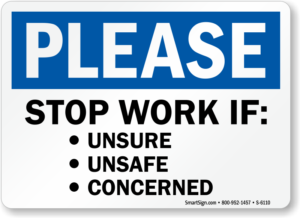
Safety News
July 2022
See Something, Say Something: STOP Work Authority  Stop Work Authority
Stop Work Authority
When performing work, it is important that an employee feels empowered and is knowledgeable that he/she has the authority to stop work if an unsafe hazard is evident that prohibits the employee from conducting a task. Stopping work is, at times, a sensitive power depending on the industry. There are employees that are fearful to use this power. The lack of confidence that employees have to exercise this right can escalate a situation and make a situation worse than it needs to be.
Reasons Why Employees Hesitate to Use Stop Work Authority
- Fear of punishment from supervisor
- Fear of conflict with other employees
- Doesn’t want to be considered a “snitch” or “soft worker”
- Fear of losing job
- Doesn’t want to slow project or work down
Clearly, many of the reasons why employees hesitate to exercise stop work authority revolve around fear of losing something. One recommendation to feel more confident about using stop work authority is to review all hazards associated with your job and position with your Human Resources manager and explain any grey areas that might exist.
Despite what many employers and groups express or claim, stop work authority is not just a privilege, it is a responsibility. Your job as a safe employee is to be the first set of eyes and voice while on the clock. At the end of the day, stopping work can keep you, your coworkers, and your company safe.
“But Sam, it’s not that simple. I tried stopping work and my boss yelled at me and threatened to fire me.”
Unfortunately, some managers care more about how quickly a job gets completed than the safety of their workers. Many of these managers feel threatened or fearful that if one of their employees stops work, the higher ups in that company may think the manager does not have control over their group. This is not the case though! Your choice and ability to identify a risk or potential hazard can save a lot of harm, if conducted correctly.
Stop Work Abuse
As mentioned earlier, stop work authority is a power that comes with great responsibility. Many employers and managers have fears that employees may tend to abuse this power to get out of work. Because of this, it is important that safety talks be conducted prior to beginning a job or task to make sure all parties are aware of the potential hazards. Abuse of stop work authority can lead to reprehension and loss of job security. Be honest, be safe, and if you see something, say it.
How to Stop Work
 If you see a potential hazard, risk or unsafe action, your job is to contact your direct supervisor or safety representative immediately. Also, alert any co-workers or employees that are assigned to the specific task as well. At that point, the manager or safety representative will analyze the issue and take corrective actions in order to resolve the issue.
If you see a potential hazard, risk or unsafe action, your job is to contact your direct supervisor or safety representative immediately. Also, alert any co-workers or employees that are assigned to the specific task as well. At that point, the manager or safety representative will analyze the issue and take corrective actions in order to resolve the issue.
Final Thoughts
All things considered, stop work is a crucial responsibility that employees should feel comfortable exercising. If there is a potential safety hazard that could cause an accident, the issue should be made known. Knowing the steps for how to stop work and who to approach is the first step of using this responsibility to create a safer work environment. If you have issues or fear of using such authority, contact your supervisor directly and your Human Resources team to make you feel comfortable in the workplace.
Why is Sleep Important?
The importance of adequate sleep cannot be overstated.  Sleep has many effects on a variety of aspects of our health. The way you feel awake has a link to what kind of sleep you get at night. Poor sleeping habits can lead to an acute sudden incident, such as a car crash due to a tired driver, or chronic problems over the long term such as a number of health issues.
Sleep has many effects on a variety of aspects of our health. The way you feel awake has a link to what kind of sleep you get at night. Poor sleeping habits can lead to an acute sudden incident, such as a car crash due to a tired driver, or chronic problems over the long term such as a number of health issues.
Research has shown up to 40% of Americans are sleep deprived. This causes many issues in the workplace and at home while completing tasks. For example, driver sleepiness is a factor in about 100,000 car accidents each year, resulting in about 1,500 deaths. Studies have also shown that sleep deprivation can significantly reduce workers’ reaction time, motor control, decision-making ability, and situational awareness. This creates an unsafe condition where a worker, or a whole jobsite, is exposed to a potential incident that could cause injury.
Sleep and Your Health
- It affects your ability to learn and remember new information.
- It affects your ability to pay attention.
- It affects your heart and cardiovascular system. There is a link between long-term sleep deficiencies and heart disease.
- It affects how your body reacts to insulin. Sleep deficiency leads to higher blood sugar levels; leaving you at a higher chance to be diagnosed with diabetes.
 Tips to be Well Rested
Tips to be Well Rested
- Get at least seven hours of sleep. Studies vary on exactly how much each person needs, but the consensus is between six and eight hours.
- Shut your TV off and place your phone face down. Blue light and other light sources can disrupt your sleep.
- Avoid naps during the day. Naps can throw off your internal clock for rest at night. If napping is a must during the day keep it under 20 minutes.
- Keep your room between 68 and 72 degrees Fahrenheit. This is the range that is best for sleeping conditions for most people.
- Go to bed and wake up at the same time every night. This keeps your internal clock on track and your body gets into a routine.
Discussion points:
- Do you feel that you get much rest every night?
- Have you ever experienced a time when you did not remember driving down the road? How could a situation like that affect our work if it were to happen here?
REMEMBER TO STAY COOL WHEN OUT IN THIS HEAT
